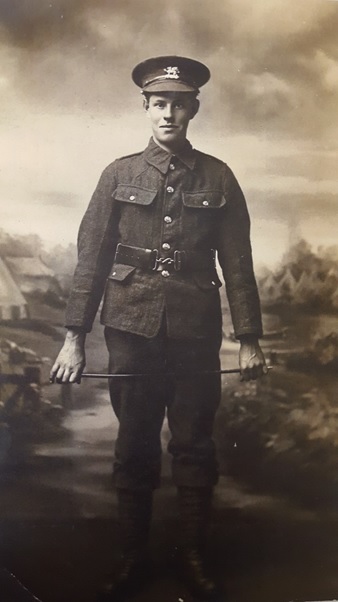Pte
Edward James Griggs
Information about birth
|
Year of birth: 1897 |
|
Place of birth: Brabourne, Kent, England, United Kingdom |
General information
|
Last known residence: Stowting, Kent, England, United Kingdom |
|
Profession: Day laborer |
|
Religion: Church of England |
Army information
|
Country: England, United Kingdom |
|
Force: British Expeditionary Force |
|
Rank: Private |
|
Service number: G/18505 |
|
Enlistment place: Ashford, Kent, England, United Kingdom |
|
Units: — The Buffs (East Kent Regiment), 7th Bn. (Last known unit) |
Information about death
|
Date of death: 14/10/1917 |
|
Place of death: Gwalia Farm, Poperinge, Belgium |
|
Cause of death: Died of wounds (D.O.W.) |
|
Age: 20 |
Cemetery
|
Gwalia Cemetery Plot: II Row: D Grave: 19 |
Distinctions and medals 2
|
British War Medal Medal |
|
Victory Medal Medal |
Points of interest 5
| #1 | Place of birth | ||
| #2 | Last known residence | ||
| #3 | Enlistment place | ||
| #4 | Place of wounding | ||
| #5 | Place of death (approximate) |
My story
Private Edward James Griggs - a farm labourer from Ashford, Kent - served in 7th Battalion The Buffs (East Kent Regiment), part of the 55th Brigade of the 18th (Eastern) Division. The 20-year-old died on 14 October 1917 during the Battle of Passchendaele.
On 12 October 1917, his unit took part in the First Battle of Passchendaele. During this battle, the 55th Brigade attacked the ruins of Poelcapelle towards Meunier House. The 8th East Surrey Regiment was on the right, the 7th Buffs in the middle and the 7th Royal West Kent Regiment on the left.
The attack was launched at 5.25am. ‘D’ and ‘C’ Companies of the 7th Buffs were the first to advance. It quickly became clear, however, that the attack would not go as planned. Due to the boggy terrain, the men struggled to advance. Moreover, the covering barrage was too irregular and weak. It therefore failed to silence the reinforced German positions. Both ‘D’ and ‘C’ companies soon came under heavy machine-gun fire. ‘D’ Company was shelled from Helles House and Requette Farm, while ‘C’ Company came under fire from Gloster Farm and Point 37. As ‘D’ Company advanced further towards Meunier House, it was fired upon from Meunier House and from the Brewery. Further advance was virtually impossible. Posts were dug, but the devastating machine-gun fire was simply to strong and the men were forced to set up a series of posts just outside their initial line.
Edwards' Battalion remained in the frontline until the next day. Although the 13th of October was relatively quiet, The Buffs' positions were shelled between 4pm and 5.30pm. By 9pm, the entire battalion had been relieved. Casualties were high. From 12 to 13 October, 385 men of The 7th Buffs were killed, wounded or missing.
Twenty-year-old Edward James Griggs was was wounded and evacuated to Poperinge. He succumbed to his wounds on 14 October 1917 and was buried in Gwalia Cemetery, which lay between the camps in flat, wet land used by field ambulances.
On 12 October 1917, his unit took part in the First Battle of Passchendaele. During this battle, the 55th Brigade attacked the ruins of Poelcapelle towards Meunier House. The 8th East Surrey Regiment was on the right, the 7th Buffs in the middle and the 7th Royal West Kent Regiment on the left.
The attack was launched at 5.25am. ‘D’ and ‘C’ Companies of the 7th Buffs were the first to advance. It quickly became clear, however, that the attack would not go as planned. Due to the boggy terrain, the men struggled to advance. Moreover, the covering barrage was too irregular and weak. It therefore failed to silence the reinforced German positions. Both ‘D’ and ‘C’ companies soon came under heavy machine-gun fire. ‘D’ Company was shelled from Helles House and Requette Farm, while ‘C’ Company came under fire from Gloster Farm and Point 37. As ‘D’ Company advanced further towards Meunier House, it was fired upon from Meunier House and from the Brewery. Further advance was virtually impossible. Posts were dug, but the devastating machine-gun fire was simply to strong and the men were forced to set up a series of posts just outside their initial line.
Edwards' Battalion remained in the frontline until the next day. Although the 13th of October was relatively quiet, The Buffs' positions were shelled between 4pm and 5.30pm. By 9pm, the entire battalion had been relieved. Casualties were high. From 12 to 13 October, 385 men of The 7th Buffs were killed, wounded or missing.
Twenty-year-old Edward James Griggs was was wounded and evacuated to Poperinge. He succumbed to his wounds on 14 October 1917 and was buried in Gwalia Cemetery, which lay between the camps in flat, wet land used by field ambulances.
Sources 2
|
7 Battalion Buffs (East Kent Regiment) (The National Archives, Kew (TNA), WO 95/2049/1). http://www.nmarchive.com/ Sources used |
|
Census Returns of England and Wales, 1911 (The National Archives, Kew (TNA), RG14). https://www.nationalarchives.gov.uk/ Sources used |
More information 3
|
Commonwealth War Graves Commission Database https://www.cwgc.org/find-records/find-war-dead/casualty-details/442665 |
|
Lives of the First World War (Imperial War Museum) https://livesofthefirstworldwar.iwm.org.uk/lifestory/1480841 |
|
Namenlijst (In Flanders Fields Museum) https://namenlijst.org/publicsearch/#/person/_id=a52c3f40-a3e1-4e7b-a3ab-5bd203bfa9bd |
